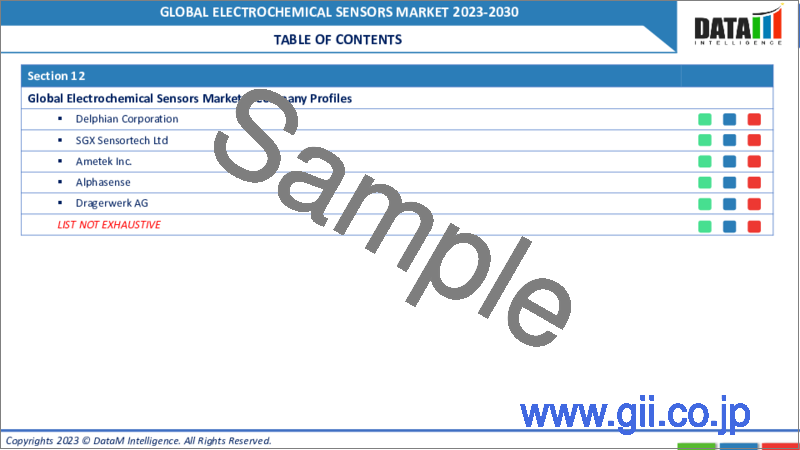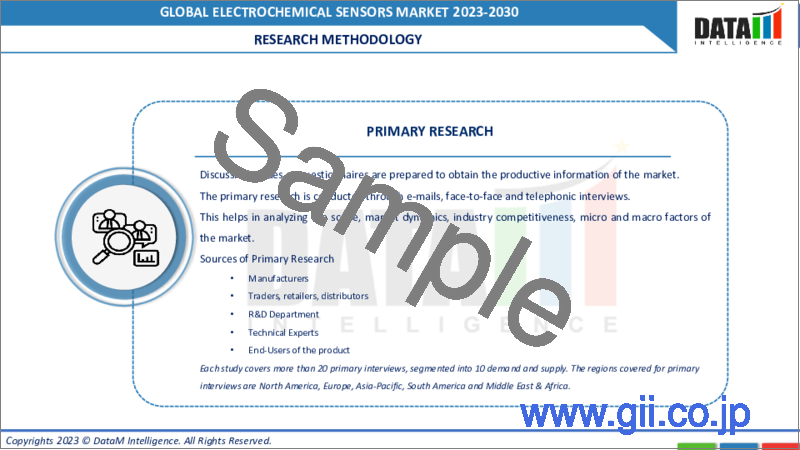|
|
市場調査レポート
商品コード
1074183
電気化学センサーの世界市場(2022年~2029年)Global Electrochemical Sensors Market - 2022-2029 |
||||||
|
● お客様のご希望に応じて、既存データの加工や未掲載情報(例:国別セグメント)の追加などの対応が可能です。 詳細はお問い合わせください。 |
|||||||
| 電気化学センサーの世界市場(2022年~2029年) |
|
出版日: 2022年05月07日
発行: DataM Intelligence
ページ情報: 英文 204 Pages
納期: 約2営業日
|
- 全表示
- 概要
- 目次
当レポートでは、世界の電気化学センサー市場について調査分析し、市場力学、業界分析、市場分析、競合情勢など、体系的な情報を提供しています。
目次
第1章 世界の電気化学センサーの調査手法と範囲
- 調査手法
- 調査の目的と調査範囲
第2章 世界の電気化学センサー市場-市場の定義と概要
第3章 世界の電気化学センサー市場-エグゼクティブサマリー
- 市場の内訳:タイプ別
- 市場の内訳:アプリケーション別
- 市場の内訳:エンドユーザー別
- 市場の内訳:地域別
第4章 世界の電気化学センサー市場-市場力学
- 市場に影響を与える要因
- 促進要因
- 抑制要因
- 市場機会
- 影響分析
第5章 世界の電気化学センサー市場-業界分析
- ポーターのファイブフォース分析
- サプライチェーン分析
- 価格分析
- 規制分析
第6章 世界の電気化学センサー市場-COVID-19分析
- 市場でのCOVID-19の分析
- COVID-19以前の市場シナリオ
- 現在のCOVID-19の市場シナリオ
- COVID-19以後の市場シナリオ/将来の市場シナリオ
- COVID-19における価格の力学
- 需要と供給のスペクトル
- パンデミック時の市場に関連する政府のイニシアチブ
- メーカーの戦略的イニシアチブ
- 結論
第7章 世界の電気化学センサー市場:タイプ別
- イントロダクション
- 市場規模分析および前年比成長分析(%:タイプ別
- 市場魅力指数:タイプ別
- 電位差滴定*
- イントロダクション
- 市場規模分析および前年比成長分析(%)
- インピーダンス測定
- 導電率測定
- ボルタンメトリー
- その他
第8章 世界の電気化学センサー市場:アプリケーション別
- イントロダクション
- 市場規模分析および前年比成長分析(%):アプリケーション別
- 市場魅力指数:アプリケーション別
- ガスセンサー*
- イントロダクション
- 市場規模分析および前年比成長分析(%)
- 重金属センサー
- バイオセンサー
- その他
第9章 世界の電気化学センサー市場:エンドユーザー別
- イントロダクション
- 市場規模分析および前年比成長分析(%):エンドユーザー別
- 市場魅力指数:エンドユーザー別
- 石油・ガス*
- イントロダクション
- 市場規模分析および前年比成長分析(%)
- 化学・石油化学
- 医学
- 自動車
- 食品・飲料
- その他
第10章 世界の電気化学センサー市場:地域別
- イントロダクション
- 市場規模分析および前年比成長分析(%):地域別
- 市場魅力指数:地域別
- 北米
- 欧州
- 南米
- アジア太平洋
- 中東とアフリカ
第11章 世界の電気化学センサー市場-競合情勢
- 競合シナリオ
- 市場ポジショニング/シェア分析
- 合併と買収の分析
第12章 世界の電気化学センサー市場-企業プロファイル概要
- Thermo Fisher Scientific, Inc.*
- 企業概要
- 製品ポートフォリオおよび説明
- 主要ハイライト
- 財務概要
- MSA Safety
- Emerson Electric Co.
- Honeywell International Inc.
- Conductive Technologies Inc.
- Delphian Corporation
- SGX Sensortech Ltd
- Ametek Inc.
- Alphasense
- Dragerwerk AG
第13章 世界の電気化学センサー市場-重要考察
第14章 世界の電気化学センサー市場-DataM
- 付録
- 当社・サービスについて
- 問い合わせ先
Market Overview
The global electrochemical sensors market has reached US$ XX million in 2021 and is expected to reach US$ XX million by 2029, growing at a CAGR of XX% during the forecast period 2022-2029.
Electrochemical sensors are devices that couple a chemically selective layer to an electrochemical transducer to deliver details about the chemical composition of a solution in real-time. The chemical energy of the selective contact between the chemical species and the sensor is therefore converted into a signal that can be used analytically.
Depending on the electrical magnitude used for recognition event transduction, different families of electrochemical sensors can be identified: potentiometric, impedimetric, conductometric and voltammetric or amperometric. The sensors are utilized for different purposes, such as to track the change of conductance, impedance and other parameters.
Electrochemical sensors are commonly used to detect harmful gases at parts per million (ppm) levels and oxygen at the percent of volume levels. There are toxic gas sensors for various gases, including nitrogen dioxide, carbon monoxide, sulfur dioxide, hydrogen sulfide and others. The sensors function well in portable and fixed gas monitors to monitor dangerous gases and the percent of volume oxygen present.
Market Dynamics
Incorporating biosensors into various diagnostic medical devices drives the global electrochemical sensors market. However, short or limited shelf life is expected to impede the market.
The incorporation of biosensors into various diagnostic medical devices
The electrochemical biosensor is a common sensing device that converts biological processes into electrical signals. An electrode is a critical component in this sensor, serving as a stable foundation for biomolecule immobilization and electron flow. Synergic effects are enabled by boosting loading capacity and mass transit of reactants to obtain excellent analytical sensitivity performance, thanks to many nanomaterials with large surface areas.
Various electrochemistry-driven biosensing approaches for inexpensive and small analytical devices for on-site analysis have recently been introduced. The trend can be used to replace commercial lab instruments made by well-known in vitro diagnosis businesses that advertise great sensitivity and automation when measuring analytes.
Moreover, electrochemical biosensors are a new way to detect viral nucleic acids or antigens and they could help with the development of COVID-19 testing at the point of care. Using "point-of-care-testing" (POCT) procedures is advantageous since it allows for the instant assessment of a patient's negative/positive status at the testing site within minutes or one hour. Many POCT techniques could be effective in this situation.
For instance, in January 2022, researchers successfully constructed an electrochemical immunosensor to identify COVID-19 antibody indication spike protein quickly. Detecting and monitoring modest amounts of COVID-19 in the early stages of the disease could help to curb the current COVID-19 pandemic's asymptomatic spread.
Short or limited shelf life
An electrochemical sensor has a shorter shelf life of some months to a year, depending on the environment in which it is used and the gas to be detected. Low humidity and high temperatures can also cause the electrolyte in the sensors to dry out. The electrolyte is depleted by exposure to the target gas or cross-sensitivity gases. In addition, they are temperature sensitive. Hence the sensors are usually internally temperature adjusted. It is preferable to keep the sample temperature as constant as possible.
COVID-19 Impact Analysis
The COVID-19 pandemic has created a market for improving current diagnostic procedures and developing new methods for confirming SARS-CoV-2 infection quickly, cost-effectively and user-friendly. The capacity of electrochemical sensors to convert fluctuations in powerful bioactive chemicals into electrical impulses has shown a lot of promise. The electrochemical identification system has a lot of potential for creating techniques like remote-controlled monitoring or on-site fast detection utilizing a mobile phone because of its high responsiveness and ease of processing.
Segment Analysis
Based on type, the global electrochemical sensors market is segmented into potentiometric, impedimetric, conductometric, voltammetric and others.
Potentiometric sensors assess the potential difference between two electrodes in the absence of current flow. At varying analyte concentrations, the sensors primarily detect the analyte concentration by monitoring the variation in the potential difference between reference electrodes and the working. Because of their simplicity, familiarity and low cost, potentiometric sensors have found the broadest practical application since the early 1930s. Further, potentiometric devices are divided into three categories: coated wire electrodes (CWES), ion-selective electrodes (IES) and field-effect transistors (FETs).
Moreover, the pH electrode, used for decades, is the most extensively used potentiometric device. Its success can be ascribed to several undeniable characteristics, including ease of use, speed, low cost, application to a wide concentration range and, most importantly, its extraordinarily high selectivity for hydrogen ions.
The work of various Brazilian research groups exemplifies recent advancements in the discipline. Kubota and colleagues published a review on analytical applications of conducting polymers in potentiometric sensors. It has been documented how to make a hydrogen ion-selective potentiometric electrode using a tri dodecyl amine ionophore dispersed in polyvinyl chloride (PVC) membrane or poly(1-aminoanthracene) sheets.
Geographical Analysis
The global electrochemical sensors market is segmented into North America, Europe, South America, Asia-Pacific, and Middle East & Africa based on geography.
North America is one of the world's significant markets for advanced research. Growing R&D efforts in biomedical, building automation, automotive and other end-users are driving the region's massive need. Further, the region is one of the world's leading marketplaces for modern electrical devices and control. Large-scale domestic production, technological progress in information technology and government initiatives toward disruptive technologies is expected to contribute to the market share.
Moreover, the region's market will gain even more from sustained light vehicle manufacturing and advancements in fuel efficiency and performance due to modern, high-cost universal exhaust gas oxygen sensors (UEGO). In addition, as the number of industrial explosions has increased in recent years, U.S. safety groups are attempting to enforce the standards more tightly, resulting in a rise in demand for electrochemical gas sensors for quality control and monitoring.
For instance, in September 2021, Scientists from U.S. collaborated with UK and created an antifouling nanocomposite-coated multiplexed electrochemical sensor platform that can detect SARS-CoV-2 RNA and virus-specific antibodies at the same time. The platform has demonstrated 100 percent accuracy in identifying viral RNA and anti-SARS-CoV-2 antibodies with IgG specificity.
Moreover, researchers in North America are developing innovative wearable platforms that can comfortably conform to the human body and effectively sample fluids such as sweat, tear, interstitial fluids and saliva for the electrochemical detection of biomarkers utilizing various sensing approaches amperometric enzymatic sensors and potentiometric ion-selective electrodes. With pioneering contributions from multiple leading groups, U.S. has played a crucial role in the bulk of cutting-edge wearable chemical sensor research.
Competitive Landscape
The global electrochemical sensors market is competitive and moderately consolidated with multinational and local brands. Major companies include Honeywell International Inc., Thermo Fisher Scientific, Inc., MSA Safety, Emerson Electric Co., Delphian Corporation, Conductive Technologies Inc., SGX Sensortech Ltd, Ametek Inc., Alphasense and Dragerwerk AG, among others. Further, product development, acquisition, merger, technological advancement and collaboration are the primary growth methods these companies use to improve their geographical presence to address the growing demand for electrochemical Sensors.
Honeywell International Inc.
Overview: Honeywell International Inc. is a U.S-based technology company that develops and commercializes solutions for some of the world's most important concerns, such as energy, safety, security, air travel, productivity and global urbanization. The company has four business divisions that serve customers globally. Around 99,000 individuals work for the corporation worldwide, with about 34,000 based entirely in U.S.
Product Portfolio: Honeywell International Inc. supplies Honeywell SureCell electrochemical sensors for dangerous gas detection. It features a tiny size, low power consumption and inexpensive cost. The technique overcomes traditional technology's performance limitations in high-temperature and high-humidity settings.
Key Development:
On October 6, 2021, Honeywell International Inc. announced the release of two new Bluetooth connected gas detectors that provide continuous monitoring for hazardous gases even in fog, rain, snow and other inclement weather, ensuring the safety of workers and industrial sites in the oil and gas, chemical, petrochemical and other industries.
Why Purchase the Report?
To visualize the global electrochemical sensors market segmentation by type, application, end-user and region and understand key commercial assets and players.
Identify commercial opportunities in the global electrochemical sensors market by analyzing trends and co-development.
Excel data sheet with numerous electrochemical sensors market-level data points with four segments.
PDF report consisting of cogently put together market analysis after exhaustive qualitative interviews and in-depth market study.
Product mapping available in excel consists of key products of all the major market players
The global electrochemical sensors market report would provide approximately 61 tables, 58 figures and almost 204 pages.
Target Audience 2022
Service Providers/ Buyers
Industry Investors/Investment Bankers
IT Companies
Automotive Companies
Medical Business
Research Professionals
Table of Contents
1. Global Electrochemical Sensors Methodology and Scope
- 1.1. Research Methodology
- 1.2. Research Objective and Scope of the Report
2. Global Electrochemical Sensors Market - Market Definition and Overview
3. Global Electrochemical Sensors Market - Executive Summary
- 3.1. Market Snippet by Type
- 3.2. Market Snippet by Application
- 3.3. Market Snippet by End-User
- 3.4. Market Snippet by Region
4. Global Electrochemical Sensors Market-Market Dynamics
- 4.1. Market Impacting Factors
- 4.1.1. Drivers
- 4.1.1.1. The incorporation of biosensors into various diagnostic medical devices
- 4.1.1.2. XX
- 4.1.2. Restraints
- 4.1.2.1. Short or limited shelf life
- 4.1.3. Opportunity
- 4.1.3.1. XX
- 4.1.4. Impact Analysis
- 4.1.1. Drivers
5. Global Electrochemical Sensors Market - Industry Analysis
- 5.1. Porter's Five Forces Analysis
- 5.2. Supply Chain Analysis
- 5.3. Pricing Analysis
- 5.4. Regulatory Analysis
6. Global Electrochemical Sensors Market - COVID-19 Analysis
- 6.1. Analysis of COVID-19 on the Market
- 6.1.1. Before COVID-19 Market Scenario
- 6.1.2. Present COVID-19 Market Scenario
- 6.1.3. After COVID-19 or Future Scenario
- 6.2. Pricing Dynamics Amid COVID-19
- 6.3. Demand-Supply Spectrum
- 6.4. Government Initiatives Related to the Market During Pandemic
- 6.5. Manufacturers Strategic Initiatives
- 6.6. Conclusion
7. Global Electrochemical Sensors Market - By Type
- 7.1. Introduction
- 7.1.1. Market Size Analysis and Y-o-Y Growth Analysis (%), By Type
- 7.1.2. Market Attractiveness Index, By Type
- 7.2. Potentiometric*
- 7.2.1. Introduction
- 7.2.2. Market Size Analysis and Y-o-Y Growth Analysis (%)
- 7.3. Impedimetric
- 7.4. Conductometric
- 7.5. Voltammetric
- 7.6. Others
8. Global Electrochemical Sensors Market - By Application
- 8.1. Introduction
- 8.1.1. Market Size Analysis and Y-o-Y Growth Analysis (%), By Application
- 8.1.2. Market Attractiveness Index, By Application
- 8.2. Gas Sensor*
- 8.2.1. Introduction
- 8.2.2. Market Size Analysis and Y-o-Y Growth Analysis (%)
- 8.3. Heavy Metal Sensor
- 8.4. Biosensor
- 8.5. Others
9. Global Electrochemical Sensors Market - By End-User
- 9.1. Introduction
- 9.1.1. Market Size Analysis and Y-o-Y Growth Analysis (%), By End-User
- 9.1.2. Market Attractiveness Index, By End-User
- 9.2. Oil and Gas*
- 9.2.1. Introduction
- 9.2.2. Market Size Analysis and Y-o-Y Growth Analysis (%)
- 9.3. Chemical and Petrochemicals
- 9.4. Medical
- 9.5. Automotive
- 9.6. Food & Beverages
- 9.7. Others
10. Global Electrochemical Sensors Market - By Region
- 10.1. Introduction
- 10.1.1. Market Size Analysis and Y-o-Y Growth Analysis (%), By Region
- 10.1.2. Market Attractiveness Index, By Region
- 10.2. North America
- 10.2.1. Introduction
- 10.2.2. Key Region-Specific Dynamics
- 10.2.3. Market Size Analysis and Y-o-Y Growth Analysis (%), By Type
- 10.2.4. Market Size Analysis and Y-o-Y Growth Analysis (%), By Application
- 10.2.5. Market Size Analysis and Y-o-Y Growth Analysis (%), By End-User
- 10.2.6. Market Size Analysis and Y-o-Y Growth Analysis (%), By Country
- 10.2.6.1. U.S.
- 10.2.6.2. Canada
- 10.2.6.3. Mexico
- 10.3. Europe
- 10.3.1. Introduction
- 10.3.2. Key Region-Specific Dynamics
- 10.3.3. Market Size Analysis and Y-o-Y Growth Analysis (%), By Type
- 10.3.4. Market Size Analysis and Y-o-Y Growth Analysis (%), By Application
- 10.3.5. Market Size Analysis and Y-o-Y Growth Analysis (%), By End-User
- 10.3.6. Market Size Analysis and Y-o-Y Growth Analysis (%), By Country
- 10.3.6.1. Germany
- 10.3.6.2. UK
- 10.3.6.3. France
- 10.3.6.4. Italy
- 10.3.6.5. Russia
- 10.3.6.6. Rest of Europe
- 10.4. South America
- 10.4.1. Introduction
- 10.4.2. Key Region-Specific Dynamics
- 10.4.3. Market Size Analysis and Y-o-Y Growth Analysis (%), By Type
- 10.4.4. Market Size Analysis and Y-o-Y Growth Analysis (%), By Application
- 10.4.5. Market Size Analysis and Y-o-Y Growth Analysis (%), By End-User
- 10.4.6. Market Size Analysis and Y-o-Y Growth Analysis (%), By Country
- 10.4.6.1. Brazil
- 10.4.6.2. Argentina
- 10.4.6.3. Rest of South America
- 10.5. Asia-Pacific
- 10.5.1. Introduction
- 10.5.2. Key Region-Specific Dynamics
- 10.5.3. Market Size Analysis and Y-o-Y Growth Analysis (%), By Type
- 10.5.4. Market Size Analysis and Y-o-Y Growth Analysis (%), By Application
- 10.5.5. Market Size Analysis and Y-o-Y Growth Analysis (%), By End-User
- 10.5.6. Market Size Analysis and Y-o-Y Growth Analysis (%), By Country
- 10.5.6.1. China
- 10.5.6.2. India
- 10.5.6.3. Japan
- 10.5.6.4. Australia
- 10.5.6.5. Rest of Asia-Pacific
- 10.6. Middle East and Africa
- 10.6.1. Introduction
- 10.6.2. Key Region-Specific Dynamics
- 10.6.3. Market Size Analysis and Y-o-Y Growth Analysis (%), By Type
- 10.6.4. Market Size Analysis and Y-o-Y Growth Analysis (%), By Application
- 10.6.5. Market Size Analysis and Y-o-Y Growth Analysis (%), By End-User
11. Global Electrochemical Sensors Market - Competitive Landscape
- 11.1. Competitive Scenario
- 11.2. Market Positioning/Share Analysis
- 11.3. Mergers and Acquisitions Analysis
12. Global Electrochemical Sensors Market- Company Profiles
- 12.1. Thermo Fisher Scientific, Inc.*
- 12.1.1. Company Overview
- 12.1.2. Product Portfolio and Description
- 12.1.3. Key Highlights
- 12.1.4. Financial Overview
- 12.2. MSA Safety
- 12.3. Emerson Electric Co.
- 12.4. Honeywell International Inc.
- 12.5. Conductive Technologies Inc.
- 12.6. Delphian Corporation
- 12.7. SGX Sensortech Ltd
- 12.8. Ametek Inc.
- 12.9. Alphasense
- 12.10. Dra¨gerwerk AG
LIST NOT EXHAUSTIVE
13. Global Electrochemical Sensors Market - Premium Insights
14. Global Electrochemical Sensors Market - DataM
- 14.1. Appendix
- 14.2. About Us and Services
- 14.3. Contact Us




